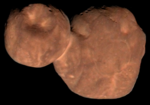Qatar-8 is a faint solar analog located in the northern circumpolar constellation Ursa Major. With an apparent magnitude of 11.71, it is impossible to detect with the naked eye, but can be located with a powerful telescope. Qatar-8 is currently 924 light-years (283 parsecs) away from the Solar System, but is drifting further away, with a radial velocity of 5.06 km/s.
Properties
Qatar-8 is a relatively old star, with an age of 8.3 billion years. At this rate, it is on the final stages of the main sequence. It has a similar effective temperature to the Sun at 5,738 K. Despite that, it has a 69% greater luminosity than the Sun. Qatar-8 has a radius 31.5% greater than the Sun, and has a similar metallicity to the Sun despite its age.
Planetary system
In 2019, the Qatar Exoplanet Survey (QES) discovered planets around Qatar-9, itself, and Qatar-10. However, Qatar-8b is a puffy Hot Saturn unlike the other planets discovered. [3]
| Companion (in order from star) |
Mass | Semimajor axis (AU) |
Orbital period (days) |
Eccentricity | Inclination | Radius |
|---|---|---|---|---|---|---|
| b | 0.371 MJ | 0.0474 | 3.719 | 0 | 89.29° | 1.285 RJ |
Since Qatar-8b is a puffy planet, it only has 37.1% the mass of Jupiter. Due to that, it puffs up to a radius that is 28.5% larger than the latter's. It also has an effective temperature of 1,457 K. Qatar-8b is ten times closer to its star than Mercury is to the Sun, which corresponds to a typical four-day orbit. [3]
Companion
Qatar-8 was suspected to have a stellar companion, which makes it a binary star. However, a study in 2020 after analysis of many other stars show no stellar companion at all.[4]
References
- ^ a b c d e Gaia Collaboration (2018-04-01). "VizieR Online Data Catalog: Gaia DR2 (Gaia Collaboration, 2018)". VizieR Online Data Catalog. 1345. Bibcode:2018yCat.1345....0G. doi:10.26093/cds/vizier.1345.
- ^ Høg, E.; Fabricius, C.; Makarov, V. V.; Urban, S.; Corbin, T.; Wycoff, G.; Bastian, U.; Schwekendiek, P.; Wicenec, A. (2000-03-01). "The Tycho-2 catalogue of the 2.5 million brightest stars". Astronomy and Astrophysics. 355: L27 – L30. Bibcode:2000A&A...355L..27H. ISSN 0004-6361.
- ^ a b c d e f g h i j k Alsubai, Khalid; Tsvetanov, Zlatan I.; Pyrzas, Stylianos; Latham, David W.; Bieryla, Allyson; Eastman, Jason; Mislis, Dimitris; Esquerdo, Gilbert A.; Southworth, John; Mancini, Luigi; Esamdin, Ali (2019-06-01). "Qatar Exoplanet Survey: Qatar-8b, 9b, and 10b---A Hot Saturn and Two Hot Jupiters". The Astronomical Journal. 157 (6): 224. arXiv:1903.09258. Bibcode:2019AJ....157..224A. doi:10.3847/1538-3881/ab19bc. ISSN 0004-6256. S2CID 85459500.
- ^ Maciejewski, G. (2020-09-01). "Search for Planets in Hot Jupiter Systems with Multi-Sector TESS Photometry. I. No Companions in Planetary Systems KELT-18, KELT-23, KELT-24, Qatar-8, WASP-62, WASP-100, WASP-119, and WASP-126". Acta Astronomica. 70 (3): 181–202. arXiv:2010.11977. Bibcode:2020AcA....70..181M. doi:10.32023/0001-5237/70.3.2. ISSN 0001-5237. S2CID 225061977.












You must be logged in to post a comment.